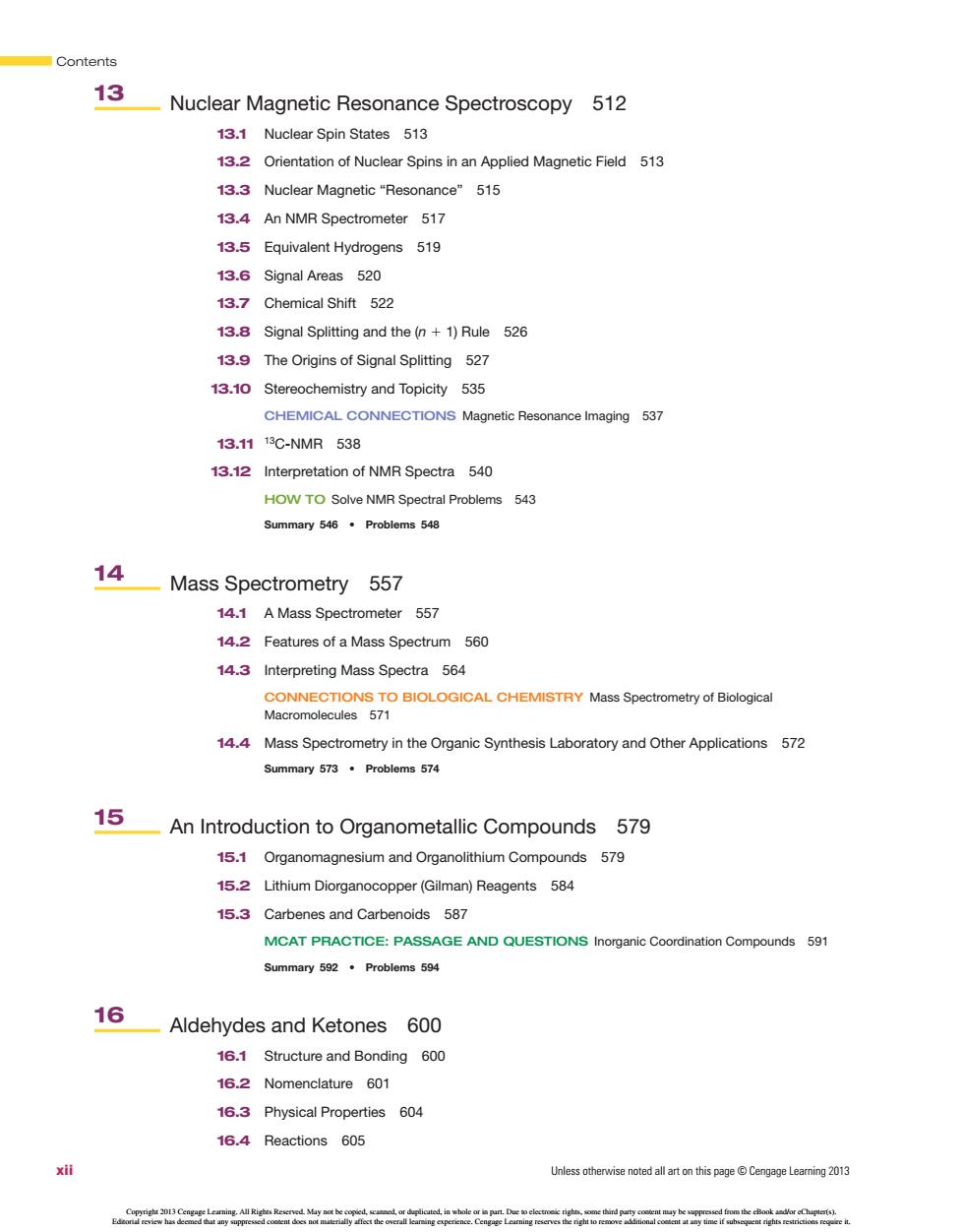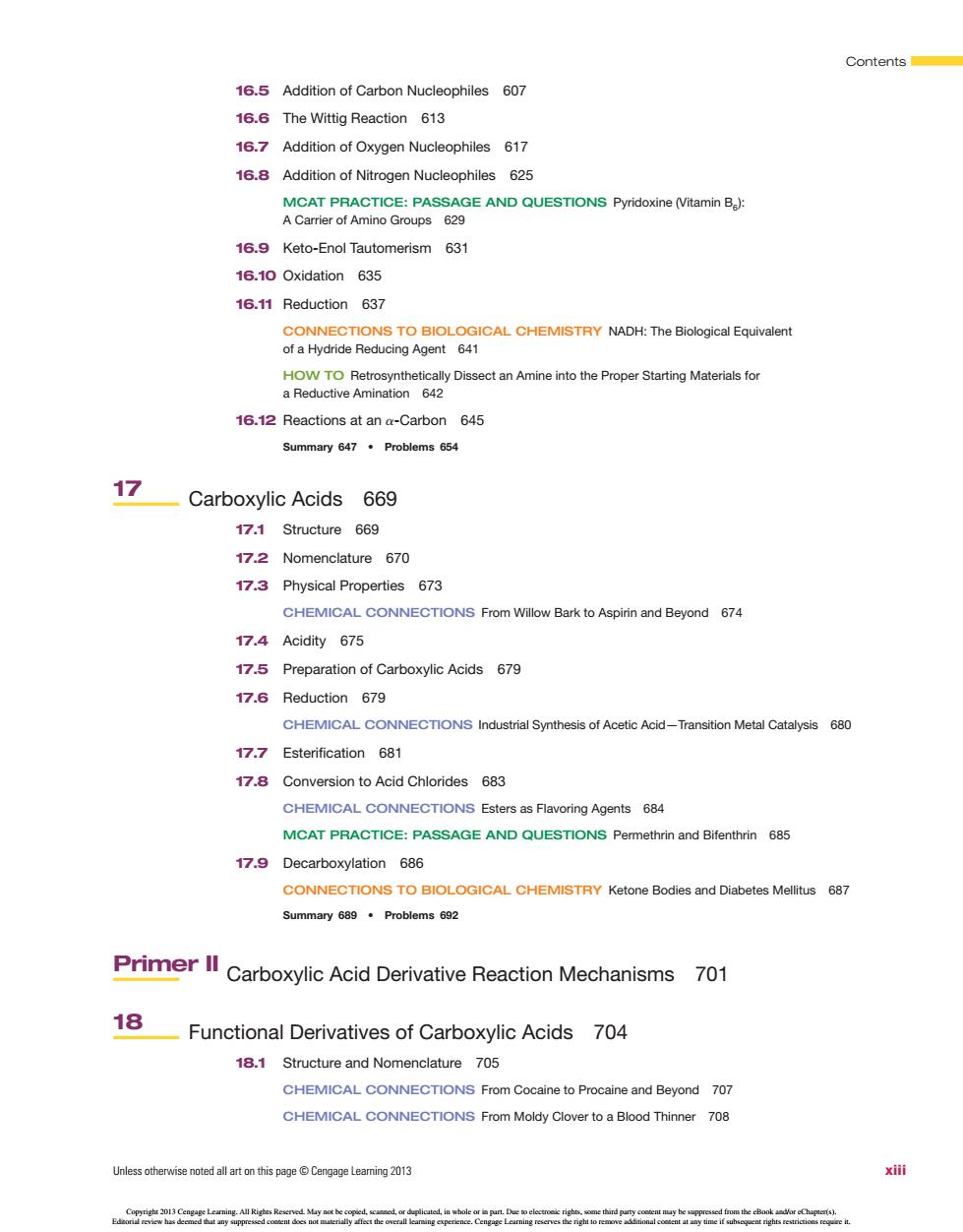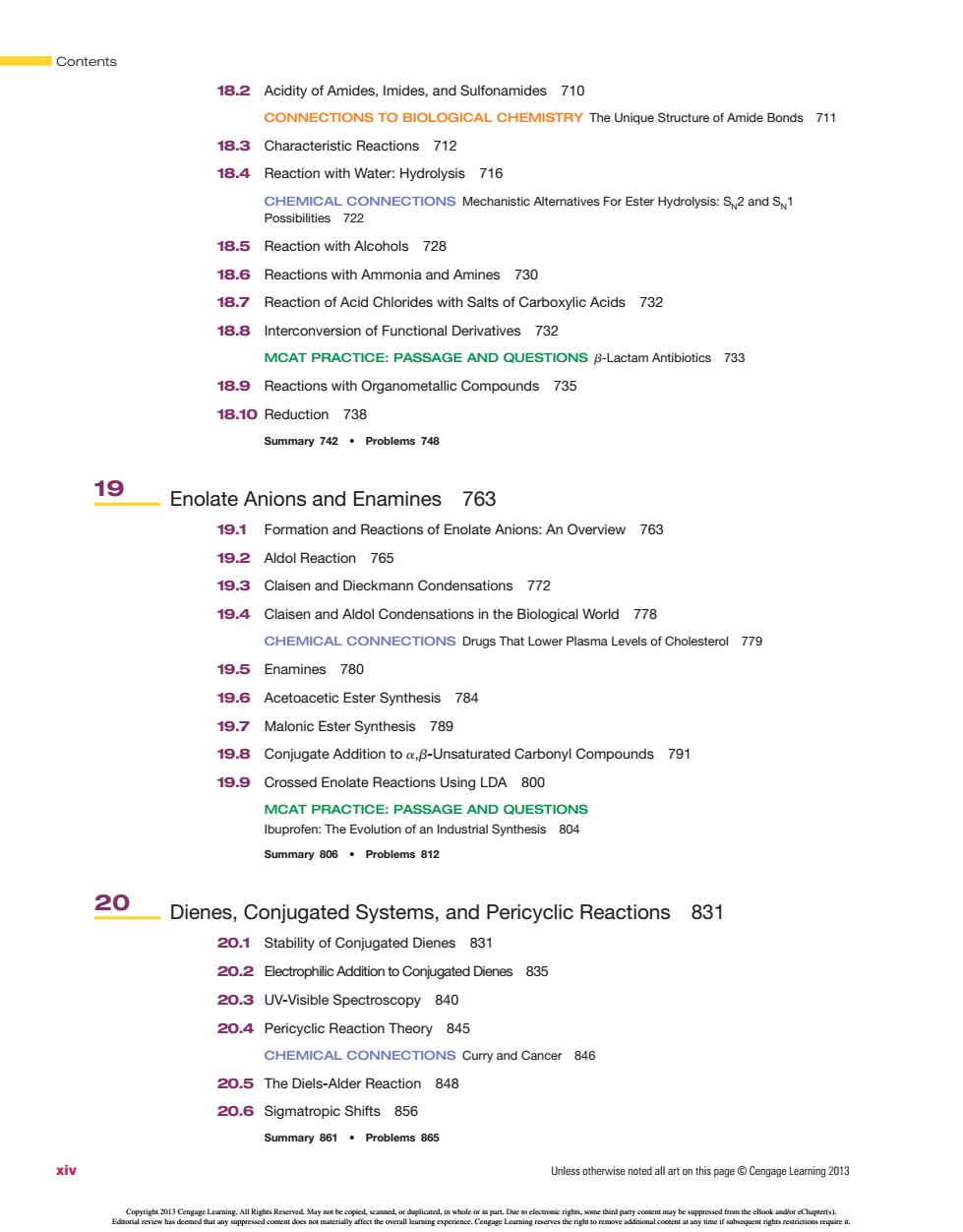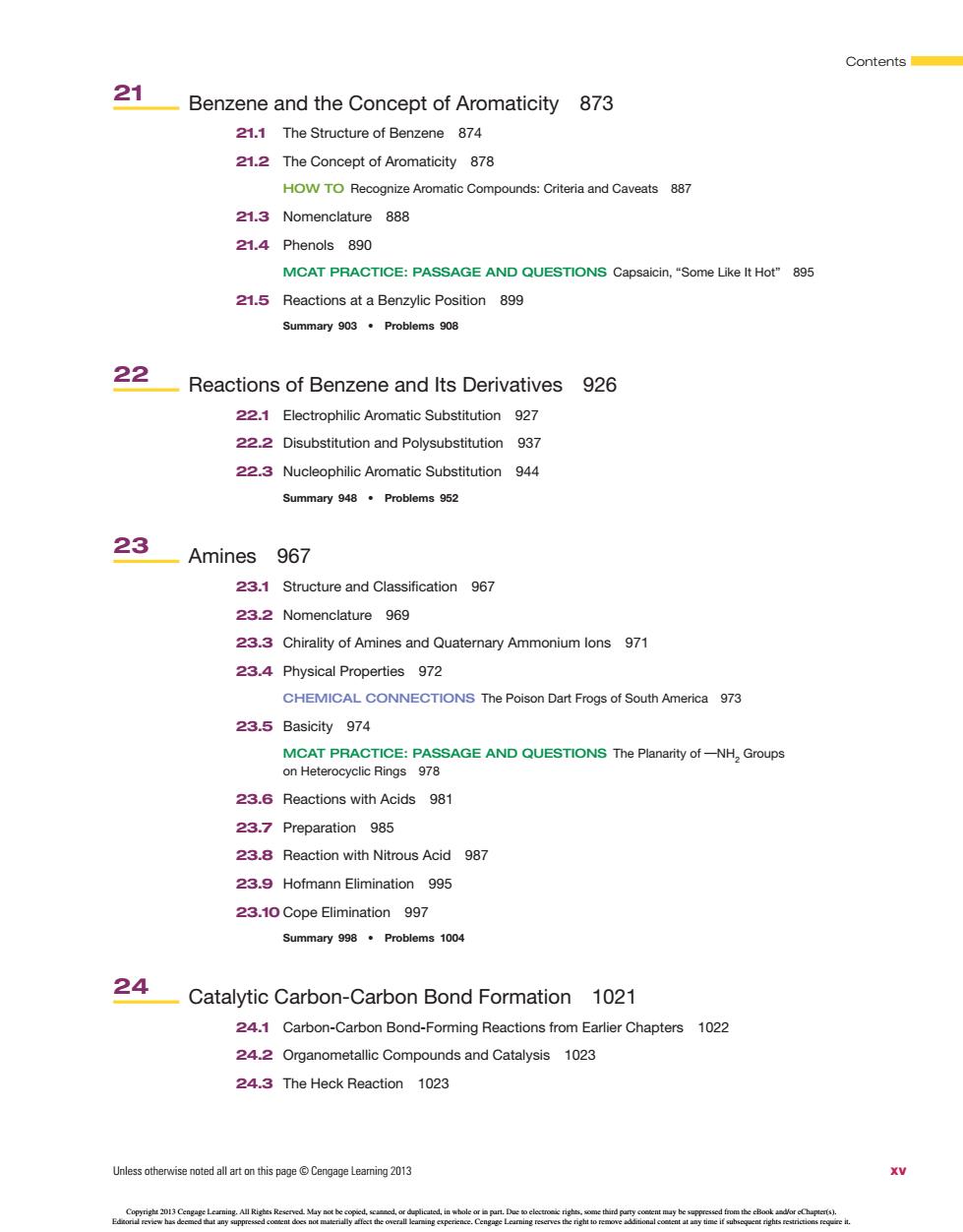
Contents 10.5 Conversion of Alcohols to Haloalkanes and Sulfonates 410 10.Acid-Catalyzed Dehydration of Alcohols 416 10.7 The Pinacol Rearrangement 421 MCAT PRACTICE:PASSAGE AND QUESTIONS Pinacol Rearrangement 423 10.8 Oxidation of Alcohols 425 CHEMICAL CONNECTIONS Blood Alcohol Screening 428 CONNECTIONS TO BIOLOGICAL CHEMISTRY The Oxidation of Aicohols by NAD 432 MCAT PRACTICE:PASSAGE AND QUESTIONS Alcohol Oxidations 433 10.9 Thiols 434 Summary 438.Problems 443 11Ethers,Epoxides,and Sulfides 451 11.1 Structure of Ethers 452 11.2 Nomenclature of Ethers 452 11.3 Physical Properties of Ethers 453 11.4 Preparation of Ethers 455 11.5 Reactions of Ethers 458 11.6 Silyl Ethers as Protecting Groups 461 11.7 Epoxides:Structure and Nomenclature 463 11.8 Synthesis of Epoxides 463 11.9 Reactions of Epoxides 468 MCAT PRACTICE:PASSAGE AND QUESTIONS Benzo[alpyrene 471 1110 Ethylene Oxide and Epichlorohydrin:Building Blocks in Organic Synthesis 472 11.11 Crown Ethers 474 11.12 Sulfides 475 Summary 477.Problems 482 12 Infrared Spectroscopy 491 12.1 Electromagnetic Radiation 491 12.2 Molecular Spectroscopy 492 12.3 Infrared Spectroscopy 493 12.4 Interpreting Infrared Spectra 498 12.5 Solving Infrared Spectral Problems 507 Summary 507.Problems 509 Unessisotel artnpe3
Unless otherwise noted all art on this page © Cengage Learning 2013 Contents xi 10.5 Conversion of Alcohols to Haloalkanes and Sulfonates 410 10.6 Acid-Catalyzed Dehydration of Alcohols 416 10.7 The Pinacol Rearrangement 421 MCAT PrACTICE: PASSAgE And QuESTIonS Pinacol Rearrangement 423 10.8 Oxidation of Alcohols 425 CHEMICAL ConnECTIonS Blood Alcohol Screening 428 ConnECTIonS To BIoLogICAL CHEMISTry The Oxidation of Alcohols by NAD1 432 MCAT PrACTICE: PASSAgE And QuESTIonS Alcohol Oxidations 433 10.9 Thiols 434 Summary 438 • Problems 443 11 Ethers, Epoxides, and Sulfides 451 11.1 Structure of Ethers 452 11.2 Nomenclature of Ethers 452 11.3 Physical Properties of Ethers 453 11.4 Preparation of Ethers 455 11.5 Reactions of Ethers 458 11.6 Silyl Ethers as Protecting Groups 461 11.7 Epoxides: Structure and Nomenclature 463 11.8 Synthesis of Epoxides 463 11.9 Reactions of Epoxides 468 MCAT PrACTICE: PASSAgE And QuESTIonS Benzo[a]pyrene 471 11.10 Ethylene Oxide and Epichlorohydrin: Building Blocks in Organic Synthesis 472 11.11 Crown Ethers 474 11.12 Sulfides 475 Summary 477 • Problems 482 12 Infrared Spectroscopy 491 12.1 Electromagnetic Radiation 491 12.2 Molecular Spectroscopy 492 12.3 Infrared Spectroscopy 493 12.4 Interpreting Infrared Spectra 498 12.5 Solving Infrared Spectral Problems 507 Summary 507 • Problems 509 Copyright 2013 Cengage Learning. All Rights Reserved. May not be copied, scanned, or duplicated, in whole or in part. Due to electronic rights, some third party content may be suppressed from the eBook and/or eChapter(s). Editorial review has deemed that any suppressed content does not materially affect the overall learning experience. Cengage Learning reserves the right to remove additional content at any time if subsequent rights restrictions require it

Contents 13 -Nuclear Magnetic Resonance Spectroscopy 512 13.1 Nuclear Spin States 513 13.2 Orientation of Nuclear Spins in an Applied Magnetic Field 513 13.3 Nuclear Magnetic"Resonance"515 13.4 An NMR Spectrometer 517 13.5 Equivalent Hydrogens 519 13.6 Signal Areas 520 13.7 Chemical Shift 522 13.8 Signal Splitting and the (n+1)Rule 526 13.The Origins of Signal Splitting 527 13.10 Stereochemistry and Topicity 535 CHEMICAL CONNECTIONS Magnetic Resonance Imaging 537 13.1113℃-NMR538 13.12 Interpretation of NMR Spectra 540 HOWTO Solve NMR Spectral Problems 543 Summary 546.Problems 548 14 Mass Spectrometry 557 14.1 A Mass Spectrometer 557 14.2 Features of a Mass Spectrum 560 14.3 Interpreting Mass Spectra 564 14.4 Mass Spectrometry in the Organic Synthesis Laboratory and Other Applications 572 Summary 573.Problems 574 15 An Introduction to Organometallic Compounds 579 15.1 Organomagnesium and Organolithium Compounds 579 15.2 Lithium Diorganocopper(Gilman)Reagents 584 15.3 Carbenes and Carbenoids 587 MCAT PRACTICE:PASSAGE AND QUESTIONS Inorganic Coordination Compounds 591 Summary 592 Problems 594 16Aldehydes and Ketones 600 16.1 Structure and Bonding 600 16.2 Nomenclature 601 16.3 Physical Properties 604 16.4 Reactions 605 xii Unless otherwise noted all art on this pageCengage Learning 2013
Unless otherwise noted all art on this page © Cengage Learning 2013 Contents xii 13 Nuclear Magnetic Resonance Spectroscopy 512 13.1 Nuclear Spin States 513 13.2 Orientation of Nuclear Spins in an Applied Magnetic Field 513 13.3 Nuclear Magnetic “Resonance” 515 13.4 An NMR Spectrometer 517 13.5 Equivalent Hydrogens 519 13.6 Signal Areas 520 13.7 Chemical Shift 522 13.8 Signal Splitting and the (n 1 1) Rule 526 13.9 The Origins of Signal Splitting 527 13.10 Stereochemistry and Topicity 535 CHEMICAL ConnECTIonS Magnetic Resonance Imaging 537 13.11 13C-NMR 538 13.12 Interpretation of NMR Spectra 540 HoW To Solve NMR Spectral Problems 543 Summary 546 • Problems 548 14 Mass Spectrometry 557 14.1 A Mass Spectrometer 557 14.2 Features of a Mass Spectrum 560 14.3 Interpreting Mass Spectra 564 ConnECTIonS To BIoLogICAL CHEMISTry Mass Spectrometry of Biological Macromolecules 571 14.4 Mass Spectrometry in the Organic Synthesis Laboratory and Other Applications 572 Summary 573 • Problems 574 15 An Introduction to Organometallic Compounds 579 15.1 Organomagnesium and Organolithium Compounds 579 15.2 Lithium Diorganocopper (Gilman) Reagents 584 15.3 Carbenes and Carbenoids 587 MCAT PrACTICE: PASSAgE And QuESTIonS Inorganic Coordination Compounds 591 Summary 592 • Problems 594 16 Aldehydes and Ketones 600 16.1 Structure and Bonding 600 16.2 Nomenclature 601 16.3 Physical Properties 604 16.4 Reactions 605 Copyright 2013 Cengage Learning. All Rights Reserved. May not be copied, scanned, or duplicated, in whole or in part. Due to electronic rights, some third party content may be suppressed from the eBook and/or eChapter(s). Editorial review has deemed that any suppressed content does not materially affect the overall learning experience. Cengage Learning reserves the right to remove additional content at any time if subsequent rights restrictions require it

Contents 16.5 Addition of Carbon Nucleophiles 607 16.6 The Wittig Reaction 613 16.7 Addition of Oxygen Nucleophiles 617 16.8 Addition of Nitrogen Nucleophiles 625 MCAT PRACTICE:PASSAGE AND QUESTIONS Pyridoxine (Vitamin B ACarrier of Amino Groups 629 16.9 Keto-Enol Tautomerism 631 16.10 Oxidation 635 16.11 Reduction 637 iRAe2oenaonoeersanioea 16.12 Reactions at an a-Carbon 645 Summary 647.Problems 654 17 Carboxylic Acids 669 17.1 Structure 669 17.2 Nomenclature 670 17.3 Physical Properties 673 CHEMICAL CONNECTIONS From Willow Bark to Aspirin and Beyond 674 17.4 Acidity 675 17.5 Preparation of Carboxylic Acids 679 17.6 Reduction 679 CHEMICALCONNECTIONS Industrial Synthesis of Acetic Acid-Transition Metal Catalysis 680 17.7 Esterification 681 17.8 Conversion to Acid Chlorides 683 CHEMICAL CONNECTIONS Esters as Flavoring Agents 684 MCAT PRACTICE:PASSAGE AND QUESTIONS Pemmethrin and Bifenthrin 685 17.9 Decarboxylation 686 CONNECTIONS TO BIOLOGICAL CHEMISTRY Ketone Bodies and Diabetes Mellitus 687 Primerll Carboxylic Acid Derivative Reaction Mechanisms 701 18Functional Derivatives of Carboxylic Acids 704 18.1 Structure and Nomenclature 705 CHEMICAL CONNECTIONS From Cocaine to Procaine and Beyond 707 CHEMICAL CONNECTIONS From Moldy Clover to a Blood Thinner 708 Unessisotelartnhn3
Unless otherwise noted all art on this page © Cengage Learning 2013 Contents xiii 16.5 Addition of Carbon Nucleophiles 607 16.6 The Wittig Reaction 613 16.7 Addition of Oxygen Nucleophiles 617 16.8 Addition of Nitrogen Nucleophiles 625 MCAT PrACTICE: PASSAgE And QuESTIonS Pyridoxine (Vitamin B6): A Carrier of Amino Groups 629 16.9 Keto-Enol Tautomerism 631 16.10 Oxidation 635 16.11 Reduction 637 ConnECTIonS To BIoLogICAL CHEMISTry NADH: The Biological Equivalent of a Hydride Reducing Agent 641 HoW To Retrosynthetically Dissect an Amine into the Proper Starting Materials for a Reductive Amination 642 16.12 Reactions at an a-Carbon 645 Summary 647 • Problems 654 17 Carboxylic Acids 669 17.1 Structure 669 17.2 Nomenclature 670 17.3 Physical Properties 673 CHEMICAL ConnECTIonS From Willow Bark to Aspirin and Beyond 674 17.4 Acidity 675 17.5 Preparation of Carboxylic Acids 679 17.6 Reduction 679 CHEMICAL ConnECTIonS Industrial Synthesis of Acetic Acid—Transition Metal Catalysis 680 17.7 Esterification 681 17.8 Conversion to Acid Chlorides 683 CHEMICAL ConnECTIonS Esters as Flavoring Agents 684 MCAT PrACTICE: PASSAgE And QuESTIonS Permethrin and Bifenthrin 685 17.9 Decarboxylation 686 ConnECTIonS To BIoLogICAL CHEMISTry Ketone Bodies and Diabetes Mellitus 687 Summary 689 • Problems 692 Primer II Carboxylic Acid Derivative Reaction Mechanisms 701 18 Functional Derivatives of Carboxylic Acids 704 18.1 Structure and Nomenclature 705 CHEMICAL ConnECTIonS From Cocaine to Procaine and Beyond 707 CHEMICAL ConnECTIonS From Moldy Clover to a Blood Thinner 708 Copyright 2013 Cengage Learning. All Rights Reserved. May not be copied, scanned, or duplicated, in whole or in part. Due to electronic rights, some third party content may be suppressed from the eBook and/or eChapter(s). Editorial review has deemed that any suppressed content does not materially affect the overall learning experience. Cengage Learning reserves the right to remove additional content at any time if subsequent rights restrictions require it

Contents 18.2 Acidity of Amides,Imides,and Sulfonamides 710 CONNECTIONS TO BIOLOGICAL CHEMISTRY The Unique Structure of Amide Bonds 711 18.3 Characteristic Reactions 712 18.4 Reaction with Water:Hydrolysis 716 FEmC92rNEcToNsMechanscAemrsForEsgodoyes.82and8 18.5 Reaction with Alcohols 728 18.6 Reactions with Ammonia and Amines 730 18.7 Reaction of Acid Chlorides with Salts of Carboxylic Acids 732 18.8 Interconversion of Functional Derivatives 732 MCAT PRACTICE:PASSAGE AND QUESTIONS B-Lactam Antibiotics 733 18.9 Reactions with Organometallic Compounds 735 18.10 Reduction 738 Summary 742.Problems 748 19 Enolate Anions and Enamines 763 19.1 Formation and Reactions of Enolate Anions:An Overview 763 19.2 Aldol Reaction 765 19.3 Claisen and Dieckmann Condensations 772 19.4 Claisen and Aldol Condensations in the Biological World 778 CHEMICAL CONNECTIONS Drugs That Lower Plasma Levels of Cholesterol 779 19.5 Enamines 780 19.6 Acetoacetic Ester Synthesis 784 19.7 Malonic Ester Synthesis 789 19.8 Conjugate Addition to a.B-Unsaturated Carbonyl Compounds 791 19.Crossed Enolate Reactions Using LDA 800 MCAT PRACTICE:PASSAGE AND QUESTIONS Ibuprofen:The Evolution of an Industrial Synthesis 804 mary806·Problems812 20 Dienes,Conjugated Systems,and Pericyclic Reactions 831 20.1 Stability of Conjugated Dienes 831 20.2 ElectrophilicAddition to Conjugated Dienes 835 20.3 UV-Visible Spectroscopy 840 20.4 Pericyclic Reaction Theory 845 CHEMICAL CONNECTIONS Curry and Cancer 846 20.5 The Diels-Alder Reaction 848 20.6 Sigmatropic Shifts 856 Summary 861.Problems 865 v Unless otherwise noted all art on this pageCengage Learning 2013
Unless otherwise noted all art on this page © Cengage Learning 2013 Contents xiv 18.2 Acidity of Amides, Imides, and Sulfonamides 710 ConnECTIonS To BIoLogICAL CHEMISTry The Unique Structure of Amide Bonds 711 18.3 Characteristic Reactions 712 18.4 Reaction with Water: Hydrolysis 716 CHEMICAL ConnECTIonS Mechanistic Alternatives For Ester Hydrolysis: SN2 and SN1 Possibilities 722 18.5 Reaction with Alcohols 728 18.6 Reactions with Ammonia and Amines 730 18.7 Reaction of Acid Chlorides with Salts of Carboxylic Acids 732 18.8 Interconversion of Functional Derivatives 732 MCAT PrACTICE: PASSAgE And QuESTIonS b-Lactam Antibiotics 733 18.9 Reactions with Organometallic Compounds 735 18.10 Reduction 738 Summary 742 • Problems 748 19 Enolate Anions and Enamines 763 19.1 Formation and Reactions of Enolate Anions: An Overview 763 19.2 Aldol Reaction 765 19.3 Claisen and Dieckmann Condensations 772 19.4 Claisen and Aldol Condensations in the Biological World 778 CHEMICAL ConnECTIonS Drugs That Lower Plasma Levels of Cholesterol 779 19.5 Enamines 780 19.6 Acetoacetic Ester Synthesis 784 19.7 Malonic Ester Synthesis 789 19.8 Conjugate Addition to a,b-Unsaturated Carbonyl Compounds 791 19.9 Crossed Enolate Reactions Using LDA 800 MCAT PrACTICE: PASSAgE And QuESTIonS Ibuprofen: The Evolution of an Industrial Synthesis 804 Summary 806 • Problems 812 20 Dienes, Conjugated Systems, and Pericyclic Reactions 831 20.1 Stability of Conjugated Dienes 831 20.2 Electrophilic Addition to Conjugated Dienes 835 20.3 UV-Visible Spectroscopy 840 20.4 Pericyclic Reaction Theory 845 CHEMICAL ConnECTIonS Curry and Cancer 846 20.5 The Diels-Alder Reaction 848 20.6 Sigmatropic Shifts 856 Summary 861 • Problems 865 Copyright 2013 Cengage Learning. All Rights Reserved. May not be copied, scanned, or duplicated, in whole or in part. Due to electronic rights, some third party content may be suppressed from the eBook and/or eChapter(s). Editorial review has deemed that any suppressed content does not materially affect the overall learning experience. Cengage Learning reserves the right to remove additional content at any time if subsequent rights restrictions require it

Contents 21 Benzene and the Concept of Aromaticity 873 21.1 The Structure of Benzene 874 21.2 The Concept of Aromaticity 878 HOWTO Recognize Aromatic Compounds:Criteria and Caveats 887 21.3 Nomenclature 888 21.4 Phenols 890 MCAT PRACTICE:PASSAGE AND QUESTIONS Capsaicin,"Some Lke It Hot"895 21.5 Reactions at a Benzylic Position 899 Summary 903.Problems 908 22 Reactions of Benzene and Its Derivatives 926 22.1 Electrophilic Aromatic Substitution 927 22.2 Disubstitution and Polysubstitution 937 22.3 Nucleophilic Aromatic Substitution 944 Summary 948.Problems 952 23 Amines 967 23.1 Structure and Classification 967 23.2 Nomenclature 969 23.3 Chirality of Amines and Quaternary Ammonium lons 971 23.4 Physical Properties 972 CHEMICAL CONNECTIONS The Poison Dart Frogs of South America 973 23.5 Basicity 974 MCAT PRACTICE:PASSAGE AND QUESTIONS The Planarity of-NH,Groups on Heterocyclic Rings 978 23.6 Reactions with Acids 981 23.7 Preparation 985 23.8 Reaction with Nitrous Acid 987 23.9 Hofmann Elimination 995 23.10 Cope Elimination 997 Summary 998.Problems 100 24 _Catalytic Carbon-Carbon Bond Formation 1021 24.1 Carbon-Carbon Bond-Forming Reactions from Earlier Chapters 1022 24.2 Organometallic Compounds and Catalysis 1023 24.3 The Heck Reaction 1023 Unessisotelartnhn3
Unless otherwise noted all art on this page © Cengage Learning 2013 Contents xv 21 Benzene and the Concept of Aromaticity 873 21.1 The Structure of Benzene 874 21.2 The Concept of Aromaticity 878 HoW To Recognize Aromatic Compounds: Criteria and Caveats 887 21.3 Nomenclature 888 21.4 Phenols 890 MCAT PrACTICE: PASSAgE And QuESTIonS Capsaicin, “Some Like It Hot” 895 21.5 Reactions at a Benzylic Position 899 Summary 903 • Problems 908 22 Reactions of Benzene and Its Derivatives 926 22.1 Electrophilic Aromatic Substitution 927 22.2 Disubstitution and Polysubstitution 937 22.3 Nucleophilic Aromatic Substitution 944 Summary 948 • Problems 952 23 Amines 967 23.1 Structure and Classification 967 23.2 Nomenclature 969 23.3 Chirality of Amines and Quaternary Ammonium Ions 971 23.4 Physical Properties 972 CHEMICAL ConnECTIonS The Poison Dart Frogs of South America 973 23.5 Basicity 974 MCAT PrACTICE: PASSAgE And QuESTIonS The Planarity of !NH2 Groups on Heterocyclic Rings 978 23.6 Reactions with Acids 981 23.7 Preparation 985 23.8 Reaction with Nitrous Acid 987 23.9 Hofmann Elimination 995 23.10 Cope Elimination 997 Summary 998 • Problems 1004 24 Catalytic Carbon-Carbon Bond Formation 1021 24.1 Carbon-Carbon Bond-Forming Reactions from Earlier Chapters 1022 24.2 Organometallic Compounds and Catalysis 1023 24.3 The Heck Reaction 1023 Copyright 2013 Cengage Learning. All Rights Reserved. May not be copied, scanned, or duplicated, in whole or in part. Due to electronic rights, some third party content may be suppressed from the eBook and/or eChapter(s). Editorial review has deemed that any suppressed content does not materially affect the overall learning experience. Cengage Learning reserves the right to remove additional content at any time if subsequent rights restrictions require it